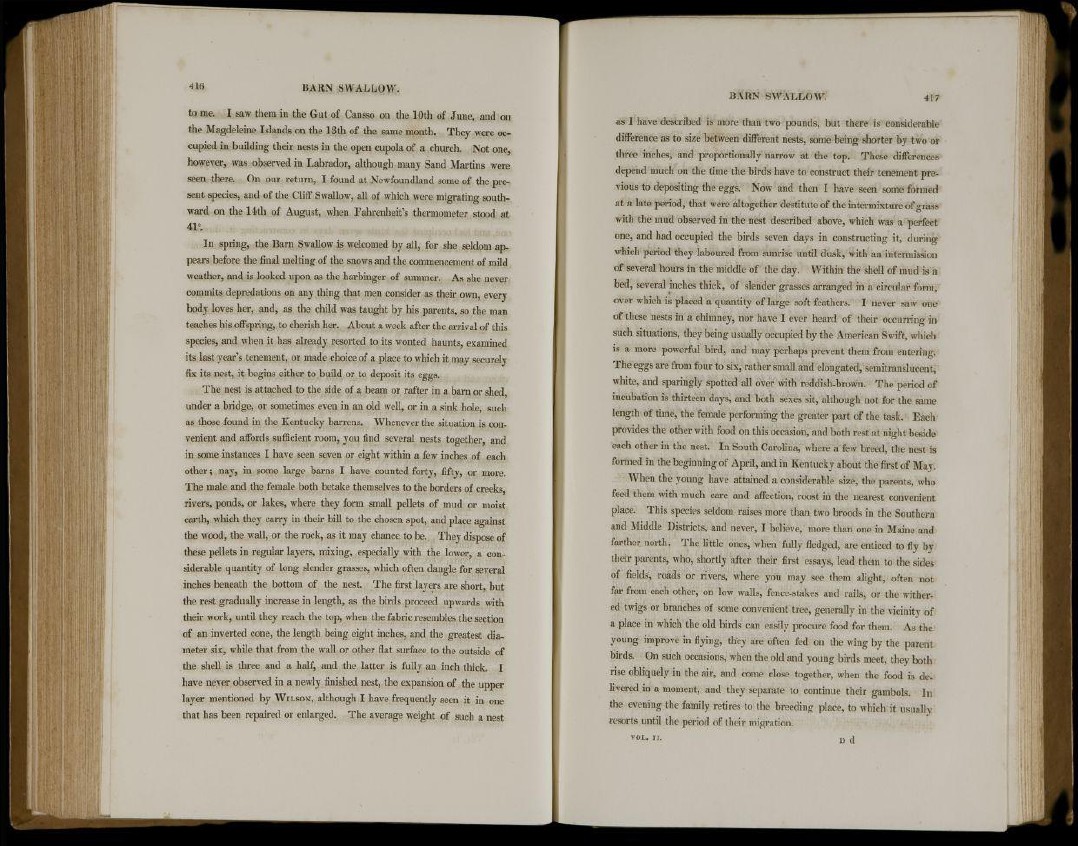
to me. I saw them in the Gut of Cansso on the 10th of June, and on
the Magdeleine Islands on the 13th of the same month. They were occupied
in building their nests in the open cupola of a church. Not one,
however, was observed in Labrador, although many Sand Martins were
seen there. On our return, I found at Newfoundland some of the present
species, and of the Cliff Swallow, all of which were migrating southward
on the 14th of August, when Fahrenheit's thermometer stood at
41°.
In spring, the Barn Swallow is welcomed by all, for she seldom appears
before the final melting of the snows and the commencement of mild
weather, and is looked upon as the harbinger of summer. As she never
commits depredations on any thing that men consider as their own, every
body loves her, and, as the child was taught by his parents, so the man
teaches his offspring, to cherish her. About a week after the arrival of this
species, and when it has already resorted to its wonted haunts, examined
its last year's tenement, or made choice of a place to which it may securely
fix its nest, it begins either to build or to deposit its eggs.
The nest is attached to the side of a beam or rafter in a barn or shed,
under a bridge, or sometimes even in an old well, or in a sink hole, such
as those found in the Kentucky barrens. Whenever the situation is convenient
and affords sufficient room, you find several nests together, and
in some instances I have seen seven or eight within a few inches of each
other; nay, in some large barns I have counted forty, fifty, or more.
The male and the female both betake themselves to the borders of creeks,
rivers, ponds, or lakes, where they form small pellets of mud or moist
earth, which they carry in their bill to the chosen spot, and place against
the wood, the wall, or the rock, as it may chance to be. They dispose of
these pellets in regular layers, mixing, especially with the lower, a considerable
quantity of long slender grasses, which often dangle for several
inches beneath the bottom of the nest. The first layers are short, but
the rest gradually increase in length, as the birds proceed upwards with
their work, until they reach the top, when the fabric resembles the section
of an inverted cone, the length being eight inches, and the greatest diameter
six, while that from the wall or other flat surface to the outside of
the shell is three and a half, and the latter is fully an inch thick. I
have never observed in a newly finished nest, the expansion of the upper
layer mentioned by WILSON, although I have frequently seen it in one
that has been repaired or enlarged. The average weight of such a nest
as I have described is more than two pounds, but there is considerable
difference as to size between different nests, some being shorter by two or
three inches, and proportionally narrow at the top. These differences
depend much on the time the birds have to construct their tenement previous
to depositing the eggs. Now and then I have seen some formed
at a late period, that were altogether destitute of the intermixture of grass
with the mud observed in the nest described above, which was a perfect
one, and had occupied the birds seven days in constructing it, during
which period they laboured from sunrise until dusk, with an intermission
of several hours in the middle of the day. Within the shell of mud is a
bed, several inches thick, of slender grasses arranged in a circular form,
over which is placed a quantity of large soft feathers. I never saw one
of these nests in a chimney, nor have I ever heard of their occurring in
such situations, they being usually occupied by the American Swift, which
is a more powerful bird, and may perhaps prevent them from entering.
The eggs are from four to six, rather small and elongated, semitranslucent,
white, and sparingly spotted all over with reddish-brown. The period of
incubation is thirteen days, and both sexes sit, although not for the same
length of time, the female performing the greater part of the task. Each
provides the other with food on this occasion, and both rest at night beside
each other in the nest. In South Carolina, where a few breed, the nest is
formed in the beginning of April, and in Kentucky about the first of May.
When the young have attained a considerable size, the parents, who
feed them with much care and affection, roost in the nearest convenient
place. This species seldom raises more than two broods in the Southern
and Middle Districts, and never, I believe, more than one in Maine and
farther north. The little ones, when fully fledged, are enticed to fly by
their parents, who, shortly after their first essays, lead them to the sides
of fields, roads or rivers, where you may see them alight, often not
far from each other, on low walls, fence-stakes and rails, or the withered
twigs or branches of some convenient tree, generally in the vicinity of
a place in which the old birds can easily procure food for them. As the
young improve in flying, they are often fed on the wing by the parent
birds. On such occasions, when the old and young birds meet, they both
rise obliquely in the air, and come close together, when the food is delivered
in a moment, and they separate to continue their gambols. In
the evening the family retires to the breeding place, to which it usually
resorts until the period of their migration.
VOL. II. n d